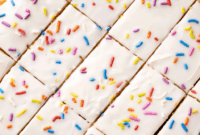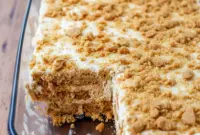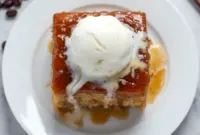Best Bread Pudding Recipe? If you want a custardy, soul-soothing dessert that everyone asks for seconds of, this Custard Bread Pudding with warm vanilla sauce might just be your new go-to.
Best Bread Pudding Recipe — Why this one works
This version nails the balance between a golden, slightly crunchy top and a feather-soft, creamy interior. The trick? thoroughly soaking the bread so every cube transforms into a tender, eggy pillow instead of a soggy lump. Use a water bath when baking and you’ll avoid curdled eggs and get a silken texture—that’s the difference between okay and exceptional.
What makes this custard bread pudding irresistible
Why does bread pudding taste like comfort in a pan? A few reasons: the custard (eggs + milk + cream) is luxurious, the bread soaks up the flavor like a sponge, and caramelized edges add textural contrast. Add a vanilla sauce and you’ve got a decadent finish that turns this simple Dessert Bread into a showstopper. Serve it warm and people will melt—literally and figuratively.
Ingredients (and why each one matters)
- Bread (stale): I used day-old French bread, but brioche or challah work brilliantly — they soak up custard and keep their shape. Bold tip: use a hearty bread; avoid flimsy supermarket loaves.
- Whole milk: forms the base of the custard and keeps the final dish rich.
- Heavy cream: increases silkiness and gives the pudding body—don’t skip it.
- Eggs: the setting agent that creates that classic Best Egg Custard texture.
- Sugar: sweetens the custard; brown sugar adds a deeper, caramel flavor if you like.
- Vanilla extract: the obvious aromatic superstar of all great Custard Recipes.
- Optional mix-ins: raisins, toasted nuts, or a splash of bourbon. For a nut-forward twist, try Almond Bread Pudding by swapping some milk for almond milk and folding in toasted sliced almonds.
- For the vanilla sauce: butter, sugar, cream, and vanilla—simple and so worth it.
Simple how-to (short & sweet)
- Cut your stale bread into 1-inch cubes; spread them on a sheet and let them dry a bit if they’re still fresh.
- Whisk milk, cream, eggs, sugar, and vanilla until smooth—no streaks of egg white. Take your time whisking; it helps the custard bind.
- Toss bread cubes into the custard and press gently so the bread soaks evenly. Leave it to sit at least 2 hours (overnight is ideal).
- Transfer soaked bread into a buttered baking dish. Place the dish in a larger roasting pan and pour hot water into the outer pan until it comes two-thirds up the side (that’s your water bath).
- Bake low and slow (about 325°F) until the center sets but still jiggles slightly—use a toothpick to check. Remove foil for the last 10–15 minutes if you want a crisp, caramelized top.
- Make the vanilla sauce while it bakes. Warm butter, sugar, cream, and vanilla; whisk until glossy. Drizzle over warm slices.
Bold tip: If the top browns too quickly, tent with foil. Protect the custard and finish slowly.

The story behind this recipe
Bread pudding started as a thrifty, delicious use for stale bread. I first learned to make it watching my grandmother rescue every leftover loaf; she turned “trash” into treasure with eggs and milk. I riffed on her method until I found the perfect custard ratio and discovered the water bath secret. This is classic comfort food elevated—still humble, but a little fancy with that vanilla sauce. If you love old-school desserts that hug you from the inside, this one’s for you.
Pro tips for the best outcome
- Use stale or slightly dried bread—it soaks up more custard without falling apart.
- Don’t rush the soak. Let the bread rest in the custard for at least 2 hours, preferably overnight; this avoids dry pockets.
- Water bath = smoother custard. It prevents curdling and encourages even cooking.
- Whisk until homogenous. No visible egg whites; whisk ~5–7 minutes for silky results.
- Check doneness by feel. The center should be set, not sloshy. If it wiggles like a jelly, give it more time.
- Cool 10–15 minutes before slicing. This firms the pudding for cleaner pieces.
- For extra richness, swap some milk for half-and-half or more cream. For a lighter dish, use whole milk only.
Bold tip: If your pan is deep, increase baking time; shallow pans cook faster.
Variations to try
- Almond Bread Pudding: Replace 1/3 cup milk with almond milk and fold in toasted sliced almonds. Finish with an almond-flavored sauce.
- Boozy bread pudding: Soak raisins in rum or bourbon and fold them in—adult-friendly and aromatic.
- Chocolate custard pudding: Add 1/2 cup cocoa powder to the custard, or fold in chocolate chips.
- Fruit-forward: Layer sliced apples or pears with the bread for a fall-ready twist.
- Gluten-free: Use a sturdy gluten-free bread and follow the same soak-and-bake method.
These swaps keep the essence of the Best Bread Pudding Recipe while letting you explore flavors.
Best ways to serve (and pairings)
Serve warm with a generous pour of vanilla sauce. For extra decadence, add a scoop of vanilla ice cream or a dollop of whipped cream. Pair with coffee, black tea, or for brunch, a sparkling wine. For a fruity contrast, serve with a raspberry or blueberry compote. This pudding works as: a cozy breakfast, a show-stopping dessert, or a comforting Dessert Bread for chilly nights.
Quick tips for storage & leftovers
- Fridge: Store in an airtight container up to 4 days. Reheat gently in the microwave or in a low oven.
- Freeze: Freeze slices wrapped tightly up to 2 months. Thaw overnight in the fridge and reheat in the oven to restore texture.
- Reheating: Warm in a 325°F oven for 10–15 minutes, covered to avoid drying out. Add sauce after reheating.
FYI: refrigeration slightly softens the crust; a quick re-crisp in the oven brings it back.
FAQs (short answers)
Can I use fresh bread?
Yes — but toast it lightly first to dry it out. Dry bread soaks better and avoids gummy pockets.
Why does my pudding feel watery after baking?
Underbaking or insufficient soak time. Bake longer and ensure the custard sets.
Do I need to use heavy cream?
No, but heavy cream makes it richer and silkier. Whole milk works for a lighter pudding.
Can I make it ahead?
Absolutely. Assemble and refrigerate overnight then bake the next day. Great for hosting.
How do I make it taste like a bakery version?
Use brioche or challah, add a splash of vanilla bean paste, and top with the vanilla sauce right before serving.
Final thoughts
This is the kind of recipe that rewards patience: a slow soak, a gentle bake, and a little love. It’s classic, forgiving, and endlessly customizable—perfect for holiday dinners and quiet Sunday indulgences alike. If you want the comfort of Yummy Sweets and a reliable Best Egg Custard-based dessert, this Custard Bread Pudding delivers every time.
Try it as written, then play around—this recipe sits at the sweet intersection of tradition and creativity. Whether you call it the Best Bread Pudding Recipe, a decadent Dessert Facile, or your new favorite Bread Recipes Sweet, it’ll earn a permanent spot in your repertoire. Ready to bake? Your kitchen smells like nostalgia already.


Custard Bread Pudding with Vanilla Sauce — Best Bread Pudding Recipe
- Total Time: 2 hours 10 minutes
Description
A silky, old-fashioned bread pudding with a crisp golden top and a soft, custardy middle. Below is the same recipe rearranged into fresh wording — same proportions, clearer steps.
Ingredients
- 1 (16-oz / 454 g) loaf French bread, cut into ~1½-inch cubes (stale or lightly toasted)
Custard mix:
- 3¾ cups whole milk
- 1½ cups heavy cream
- 7 large eggs
- 1 teaspoon vanilla extract
- 1¼ cups granulated sugar
- Optional: zest from ½ an orange
Instructions
- Prep the bread — Cut the loaf into roughly 1½-inch pieces. The drier the cubes, the better they soak the custard; toast them briefly in a 300°F oven or leave the cut bread out a day or two if it’s fresh.
- Make the custard — In a large bowl whisk together the milk, cream, eggs, vanilla, sugar and orange zest (if using). Whisk until the eggs are fully incorporated and the mixture looks smooth and uniform.
- Combine bread and custard — Place the bread cubes in a roomy glass baking dish and pour the custard over them. Toss gently so the bread is evenly coated. Press down lightly so the bread absorbs the liquid. Cover and chill in the refrigerator for a minimum of 2 hours (overnight is best). This soak time prevents dry pockets and makes the center truly custardy.
- Preheat and set up a water bath — Preheat the oven to 350°F. Cover the baking dish tightly with foil and set it inside a larger roasting pan. Pour hot or warm water into the roasting pan until it reaches about halfway up the sides of the baking dish. A water bath keeps the custard gentle and prevents curdling.
- Bake — Slide the roasting pan (with the covered dish inside) into the oven and bake about 1½ hours. Test for doneness by inserting a toothpick in the center — it should come out clean or with just a little set custard clinging. If it’s still very wobbly, bake a bit longer.
- Brown the top — Remove the foil for the last 10–20 minutes of baking to allow the top to color and crisp. Watch closely so it doesn’t overbrown.
- Rest and serve — Let the pudding sit about 10–15 minutes after removing it from the oven to firm up for neater slices. Serve warm with vanilla sauce, caramel, fresh berries, or a scoop of ice cream.
Notes
- Quick Notes & Tips
- Use a sturdy bread (French, brioche, challah, or panettone) so cubes hold up after soaking.
- Do not skip the water bath — it’s key for a smooth, non-curdled custard.
- If the top browns too fast, tent loosely with foil.
- Baking time is based on a glass ~2-quart dish; deeper dishes will need more time.
- Make-ahead: assemble and refrigerate overnight; bake the next day.
- Storage
- Refrigerate leftovers in an airtight container up to 4 days. Rewarm gently in a low oven or microwave and add sauce just before serving.
- Prep Time: 10 minutes
- Cook Time: 2 hours
- Category: Dessert
Nutrition
- Calories: 376.53kcal
- Sugar: 25.07g
- Sodium: 285.22mg
- Fat: 16.06g
- Saturated Fat: 8.73g
- Carbohydrates: 47.01g
- Fiber: 0.91g
- Protein: 11.67g
- Cholesterol: 165.64mg



